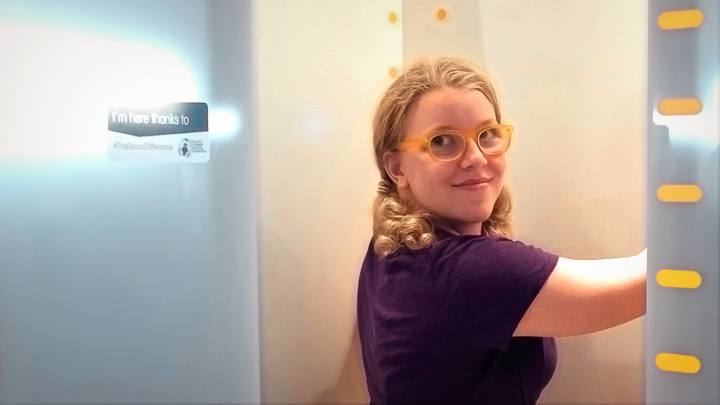
June 13, 2016

Philippa Madill, 13, has a scan using the new EOS Imaging System, a low-dose, 3D imaging system that captures whole body images of a standing patient in a single scan, at Edmonton’s Stollery Children’s Hospital.
Story by Sharman Hnatiuk; photo by Mathew Martin
EDMONTON — Philippa Madill was five the first time her spine was X-rayed. After being diagnosed with scoliosis, defined as a spinal curvature of more than 10 degrees to the right or left, the 13-year-old from Drayton Valley received X-rays each year to monitor her spine as she grew up.
Last month, Philippa had her first scan using the new EOS Imaging System, a low-dose, 3D imaging system that captures whole body images of a standing patient in a single scan, at Edmonton’s Stollery Children’s Hospital.
“I watched my older sister Hannah have as many as four X-rays per year to monitor her scoliosis,” explains Philippa. “I’m happy that I’ll be exposed to less radiation thanks to this new technology.”
The EOS Imaging System exposes children to seven to nine times less radiation than standard X-ray machines as it creates a high-quality image by scanning the spine of a patient in approximately seven seconds. The refined images are used for initial diagnosis and assessment.
The system also boasts a micro-dose setting which exposes patients to 50 times less radiation than a standard X-ray. While a micro-dose image may not be as clear as the traditional image, it’s sufficient to monitor disease progression for scoliosis patients who require follow-up imaging.
“X-rays and scans can be helpful, even life-saving, but increased exposure to radiation can lead to an increased incidence of cancer,” says Dr. Marc Moreau, a pediatric orthopedic surgeon at the Stollery. “It's important to use the lowest dose possible when scanning a child; this technology allows us to obtain the best quality imaging without compromising the safety of our patients.”
Scoliosis impacts three to five per cent of children, and typically affects girls more frequently and more severely than boys. The scoliosis clinic at the Stollery sees about 1,800 patient visits per year, with patients who often require scans every six months.
“Scoliosis is a three-dimensional deviation of the spine, but traditional X-rays only give us a two-dimensional view,” says Dr. Moreau. “This new device uses an ultra-low dose of radiation to provide extremely detailed, high-quality images. Using the EOS machine makes imaging safer for our pediatric patients and gives a more accurate perspective for diagnosis, surgical treatment and follow-up of the spine.”
The Stollery Children’s Hospital Foundation contributed $750,000 towards the machine and an additional $27,500 for the micro-dose software.